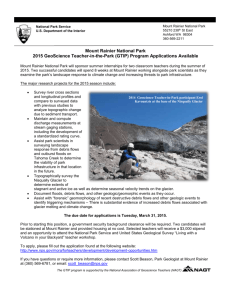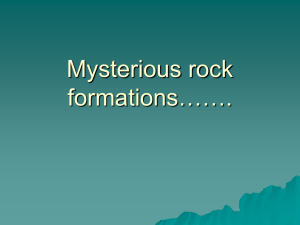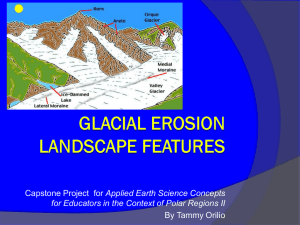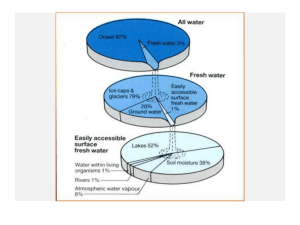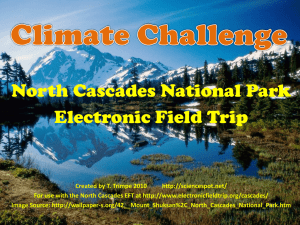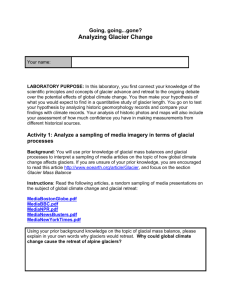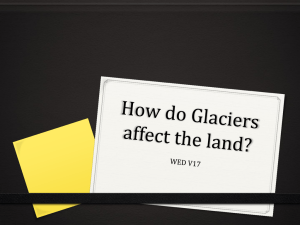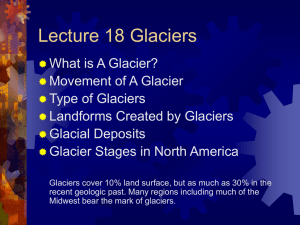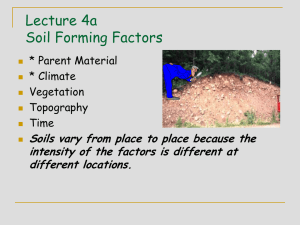GlacialLab
advertisement
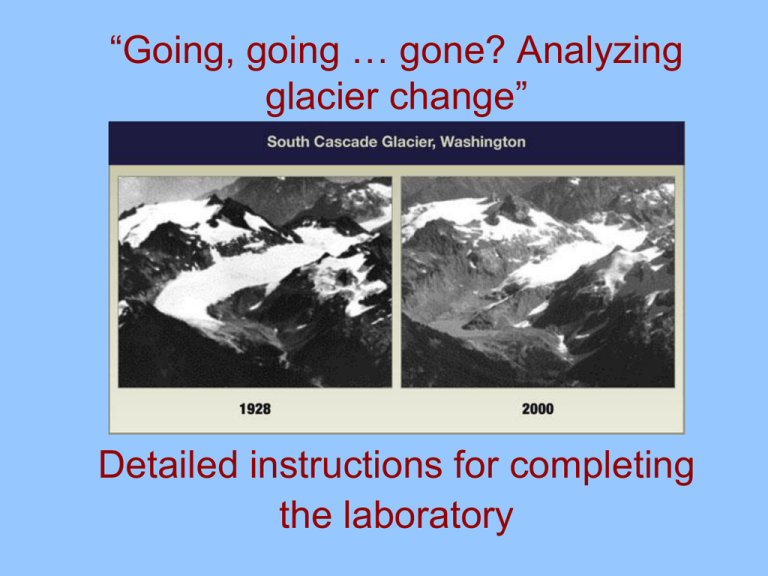
“Going, going … gone? Analyzing glacier change” Detailed instructions for completing the laboratory Organization of this Lab • Activity 1: Analyze media stories on the effect of global warming on glacial retreat in terms of glacial processes • Activity 2: Develop your hypothesis • Activity 3: Test your hypothesis by gathering data on the Nisqually Glacier • Activity 4: Compare Nisqually behavior with other glaciers • Activity 5: Predict future change to glaciers Activity 1: Analyze media stories on the effect of global warming on glacial retreat in terms of glacial processes • Many videos you can watch on YouTube: http://youtube.com/watch?v=UGclsV3JuAQ http://youtube.com/watch?v=Pem4fpMwkSQ http://youtube.com/watch?v=7MXazI568Bs Just search “glacier retreat” • Media loves the visuals of glacial retreat… Activity 1: Analyze media stories on the effect of climate change on glacial retreat in terms of glacial processes • You will read media stories Activity 2: Develop your hypothesis SODA Entire Book, The Scientific Nature of Geomorphology ed. by Rhoads & Thorn Activity 2: Develop your hypothesis • Read Hecht & Pelto; what are their hypotheses? Activity 2: Develop your hypothesis Activity 2: Develop your hypothesis Activity 3: Test your hypothesis by gathering data on the Nisqually Glacier • Background information on the study area • Methods used to study glacier change… • Task 1. You measure how the length of the Nisqually Glacier changes over time • Task 2. Analyzing uncertainty • Task 3. Plot your data • Task 4. Comparison with atmospheric temperature • Task 5. Comparison with other glacier length records Activity 3: Background on study area Activity 3: Background on study area Fly around and two QTVRs Activity 3: Background on study area Glacier in various positions “above” bridge Bridge marking previous glacier advance Activity 3: Background on study area Mt. Rainer through time (courtesy of NPS) Activity 3: Methods Lots of techniques… field methods mapping terminus historical photos ground photos maps From a Master’s thesis… Activity 3: Task 1. Measure length of Nisqually Glacier & how changes 1971 Activity 3: Task 1. Measure length of Nisqually Glacier & how changes Take a string (or ruler). Measure Activity 3: from Task the 1. Measure length of length top of Rainier. Nisqually Glacierwith & how changes Then, compare scale. Then convert km to miles. Ground Photos require that you look for features on the topographic map that can help you identify location of terminus Working with ground photos can be difficult and can have low confidence From Mt. Rainer website (photoshopped) Ground photo 1912 Trees… Cliff Activity 3: Task 2. Analyze Uncertainty Activity 3: Task 3. Plot your data Already given in data table Need to be graphed Only connect lines between 4 (high) and 3 (medium confidence) – and leave 2 & 1 unconnected Example from Glacier X at Mount Rainier Example from Glacier X at Mount Rainier High confidence ~0.1 km (100 m) range Med. confidence ~0.2-0.3 km (200300 m) range Low/VL confidence ~0.5-1 km range (guess) Inform reader: where we’re sure of the data and why…here’s our estimate…we need more research… Activity 3: Task 4. Compare with temperature records Example from Glacier X at Mount Rainier Activity 3: Task 4. Example Glacier length increasing… Global temp record shows temp increasing too… Why? Does this make sense? Low confidence for 3 years of data… Note in writing Activity 3: Task 4. Compare with temperature records—lots of noise & lots of uncertainty Blue dots = avg. annual temp Trend line Example from Glacier X at Mount Rainier What do the two graphs tell us? Write-up, noting speculative-ness and low/very low confidence levels, but possibilty… Activity 3: Task 5. Compare with other glacier length records from Oerlemans Example from Glacier X at Mount Rainier Different is OK…Glaciers have personalities…may not do what “everyone” else does Use fieldwork & maps & other datasets to help us interpret glacier’s personality Activity 4: Comparing Nisqually to other Glaciers • After scientists conduct research at their study site, most compare results with other locations to discover if their site is an anomaly or reflects a broader trend • Sometimes, scientists do this themselves and make a career studying glaciers • Sometimes, compare with other published studies Activity 4: Comparing Nisqually to other glaciers Activity 4: Comparing Nisqually to other glaciers Activity 4: Comparing Nisqually to other Glaciers Activity 5: Predict the future (~1850) 10,000 100,000 1,000,000 Activity 5: Predict the future WITHOUT anthropogenic influence… Activity 5: Predict the future Die-out completely, like Kilimanjaro? Advance in another little ice age? Activity 5: Predict the future
